The crash in yesterday’s Tour de France stage illustrates the importance of maintaining a safe passing distance. On a narrow road approximately 22 miles from the finish, 2 riders were taken down by a French media car. As the car attempted to squeeze between the lead group of 5 riders and a roadside tree, it steered into Spanish rider Juan Antonio Flecha. The impact pushed him into Dutch rider Johnny Hoogerland, who flew head over heels into a barbed wire fence. Fortunately, both riders were able to remount and finish the stage (and fortunately for both, today is a rest day on the Tour, so they have some extra recovery time).
When such an accident can befall some of the most experienced riders and capable bike handlers on a closed road, it can make bike commuting, which often requires riding on the roads with traffic seem unnecessarily dangerous. But with a little attention and effort from both cyclists and drivers, riding a bike can be just as safe as any other mode of transportation. Whether you drive all the way to work, drive part way and then park and pedal with a folding bike, or commute entirely by bike, it’s important to be aware of other road users. Here are a few simple ways to make sure that everyone gets to their destination safely, whether they’re in a car or on a bike.
Tips for Drivers
Check your blind spot: Bicycles often ride to the right of traffic. So before changing lanes, making a turn, or pulling over, check to make sure the way is clear.
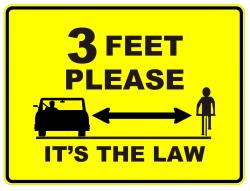 Pass at a Safe Distance: Many states have laws about what constitutes safe distance – typically 2 or 3 feet. If you’re passing a cyclist, make sure there is adequate space between your vehicle and the bike, or better yet, move to the next lane if traffic and road conditions allow. Remember that a cyclist has to respond to obstacles in their path and might swerve to avoid a pothole, glass, or other road debris. By passing at a safe distance, you allow them to respond to road conditions without having to worry about being clipped by passing cars. (You don’t want to be like the media car in the tour, do you?)
Pass at a Safe Distance: Many states have laws about what constitutes safe distance – typically 2 or 3 feet. If you’re passing a cyclist, make sure there is adequate space between your vehicle and the bike, or better yet, move to the next lane if traffic and road conditions allow. Remember that a cyclist has to respond to obstacles in their path and might swerve to avoid a pothole, glass, or other road debris. By passing at a safe distance, you allow them to respond to road conditions without having to worry about being clipped by passing cars. (You don’t want to be like the media car in the tour, do you?)
Remember that Cyclists are People too: We all have places we need to be – this, presumably, is why we’re on the road. But in some places, the road is not wide enough to safely accommodate a bike and a passing car. It can be frustrating to be “stuck” behind a bicycle, but no matter how much of a hurry you’re in, it’s not worth seriously injuring someone (or even risking it) to arrive at your destination a few minutes sooner.
Tips for Cyclists
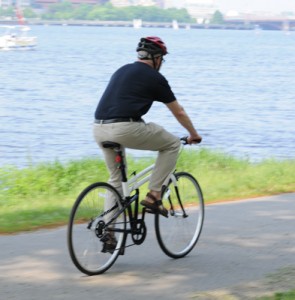 Ride a Bike Path: If you live in an area with separated bike paths, this is the safest option, since it allows you to ride in a car-free environment. Be sure to be mindful of other cyclists, stay to the right, and if it is a multi-use path, let pedestrians (and other cyclists) know when you are approaching them from behind.
Ride a Bike Path: If you live in an area with separated bike paths, this is the safest option, since it allows you to ride in a car-free environment. Be sure to be mindful of other cyclists, stay to the right, and if it is a multi-use path, let pedestrians (and other cyclists) know when you are approaching them from behind.
Choose a Low-Traffic Route: If you can’t commute on a bike path, or can’t take it all the way from point A to point B, look for quieter, lower traffic streets. While these aren’t always the shortest or most direct route, they not only have fewer cars , but also tend to have lower speed limits, making them safer for bicycles.
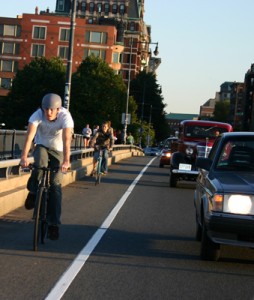 Follow the Traffic Laws: While it might be tempting to run the red light at a seemingly quiet intersection, hop up on the sidewalk, or ride the wrong way down the edge of a one-way street, you’ll be much safer riding in the road and obeying traffic signals. If you make your riding behaviour predictable to the cars around you, you will be much safer in the long run.
Follow the Traffic Laws: While it might be tempting to run the red light at a seemingly quiet intersection, hop up on the sidewalk, or ride the wrong way down the edge of a one-way street, you’ll be much safer riding in the road and obeying traffic signals. If you make your riding behaviour predictable to the cars around you, you will be much safer in the long run.
Be Aware of Car Movements: Unfortunately, as a cyclist, you can’t rely on everyone to use their turn signals or check their blind spot before turning or changing lanes. So in order to protect yourself, you need to monitor the movement of the vehicles around you. E.g. if you’re riding to the right of traffic and see a car in front of you moving over to the right, assume that it’s about to turn, and adjust your speed accordingly so you won’t be in its path.
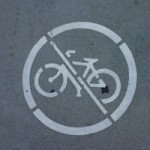 Don’t Ride on the Sidewalk: Aside from the fact that it’s illegal (for adults) in many places, the sidewalk is not where you should be riding your bike. The sidewalk is littered with obstacles, including mailboxes, streetlights, fire hydrants, and pedestrians. A bike zipping off the sidewalk at an intersection is likely to catch a driver unawares, making it an unsafe situation for everyone involved.
Don’t Ride on the Sidewalk: Aside from the fact that it’s illegal (for adults) in many places, the sidewalk is not where you should be riding your bike. The sidewalk is littered with obstacles, including mailboxes, streetlights, fire hydrants, and pedestrians. A bike zipping off the sidewalk at an intersection is likely to catch a driver unawares, making it an unsafe situation for everyone involved.
What are Your Tips for Safe Commuting?
If you’re a cyclist, what are your safety tips? Are there any particularly sketchy parts of your commute? How do you avoid/deal with them? As a driver, what do you do to keep a look out for cyclists? Any reactions to the crash on the tour? Let us hear from you, and most importantly, ride safe!

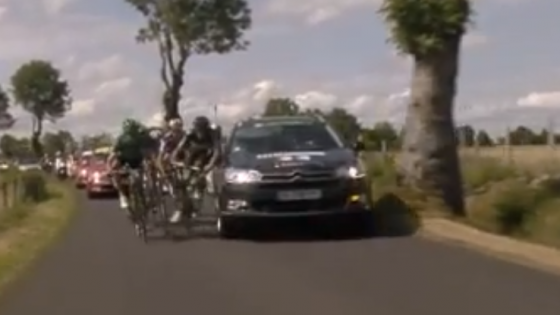

First of all : Don’t try too often to cross the steel tram lanes ,on the wrong angle, in the night, or sunset , without strong front lights on yours bike, in the rain. Someday could be fatal .
Second : Often it is very difficult to notice the debris,stones, or the wholes in the pavement, when are covered with water.
Use safety clothes, those reflective yellow ones…or reflective straps .
Also try to use handgloves, knee protection { the knee is the most difficult to recover body joint } , and Helmet . !
Left side Mirror mount on the hadlebars (for Europe) ,or Right side ,for England, is very usefull when turning or changing lanes.
I also use a Ultrasonic Dog Chaser , because in some countries they are free on the streets and tend to organize themself like the wolfes. … It could be ugly to be chased by dogs on the traffic…
Hope that my simple toughts will help any ciclysts to a safe ride.
Thanks for the tips Ionut. Very good advice about being careful with in wet conditions and wearing reflective clothing. Being seen is half the battle!